Fantasy Science Pt. 4: Time Travel & The Grandfather Paradox
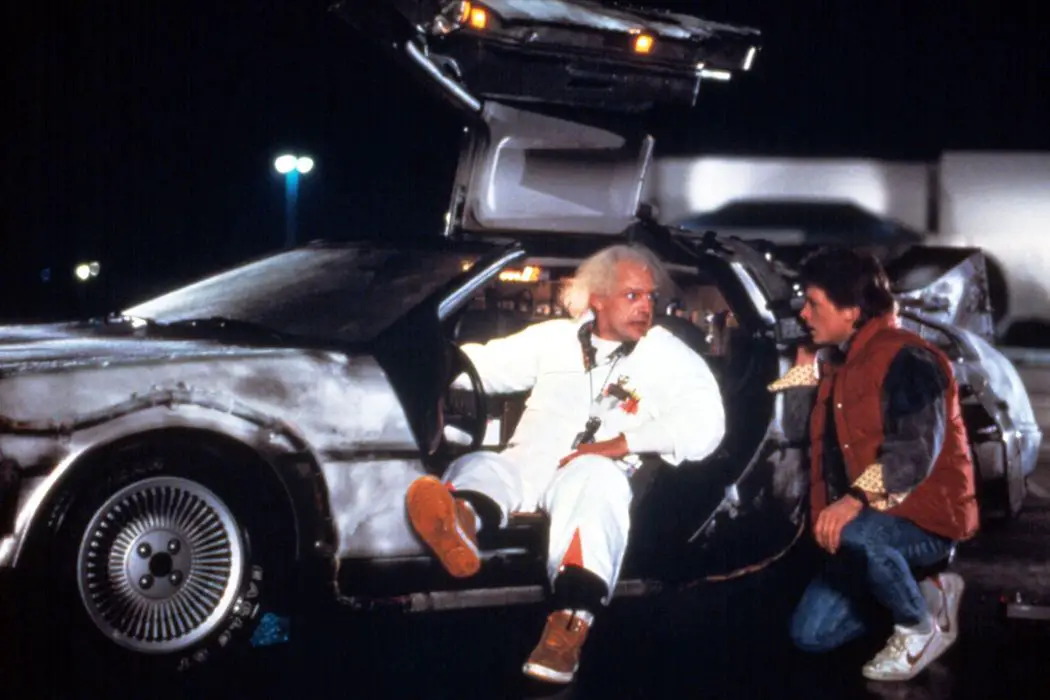
Radha has a PhD in theoretical quantum physics. Apart from…
Quantum physics. Time machines. Paradoxes. Have you heard terms like these flying around the science fiction sections of the film world? Have you ever wondered just how accurately these films portray real science? Well, my friends, today is your lucky day: this column, Fantasy Science & Coffee, aims to bridge the gap between science and science fiction in films and occasionally popular culture. My hope is to explain things in a fun way – like we’re chatting over coffee.

You may be thinking: who is this person, why does she think she can explain science, and why the heck would I want to have coffee with her? Well, I’m Radha, a researcher in India, currently pursuing a PhD in theoretical quantum physics. I quite like hot beverages. I’ll also pay.
In this fourth part of the series published on the second and fourth Tuesdays of every month, we are going to look at potential solutions to the famous grandfather paradox in the context of time travel, and how it’s addressed in two cult classics: the Back to the Future film series, and the world of Doctor Who.
Let’s begin.
If Doc Brown showed up at your doorstep with the iconic DeLorean time machine, would you hop in and travel back in time to see if you got along with your mother when she was your age?
I probably wouldn’t. Not that I have anything against her, I just think it’d be cooler to hang out with Nikola Tesla or Marie Curie if I’m going to take the time travel plunge. Sorry, mum.
One of the most recognisable pillars of science fiction is that of traveling through time. It has fascinated not just writers, but scientists as well. Why can’t we move around time the way we move around in space? Why does moving back in time lead to a plethora of dire consequences that moving backwards, say, five feet doesn’t?
While there are theoretical ways to travel to the future, let’s solely focus right now on traveling backwards in time, with the famous example of the Grandfather Paradox.
The Grandfather Paradox
It goes something like this. You are born, you grow up like a normal person, yadda yadda yadda. But then one day you invent a time machine. And for some reason you are really pissed off (maybe someone stole your inevitable Nobel Prize? Let’s not speculate.) and want to eliminate your existence. So you travel back in time, before your grandfather had a chance to meet your grandmother, and you shoot him.
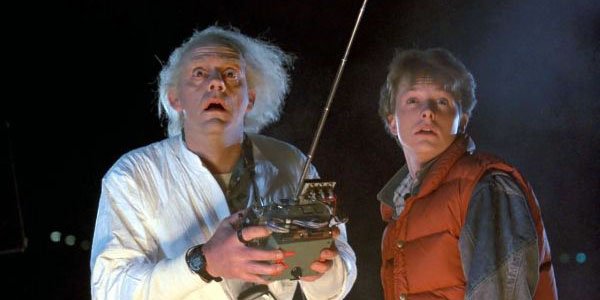
Your grandfather dies, your mother is never born, and therefore you are never born. But wait! You were the one who killed your grandfather, so if you were never born then you wouldn’t have been able to become your grandfather’s murderer. And since your grandfather doesn’t get murdered, your mother is conceived and boom! You’re born again. This is a paradox.
It is this paradox that leads people to suspect that time travel to the past can’t exist. I’m not here to speculate on whether or not time travel to the past is scientifically possible — we don’t understand how the universe works nearly enough to come up with a solid answer. But what I can do is outline a potential solution to overcome the paradox, for all you sci-fi enthusiasts, film buffs, and writers out there!
We look at two solutions with the help of two of the most famous time travellers out there: Doc Brown from Back to the Future (1985) and the Doctor from Doctor Who (1963-1989, 1996, 2005-).
Solution 1: Fixed Points in Time and Determinism
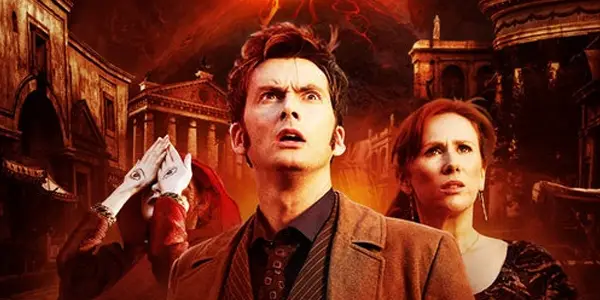
In this solution, no matter how much you try to kill your grandfather, you just can’t. The universe conspires in such a way that deaths and births just can’t be re-written. You might trip and knock yourself unconscious on your way to meet your grandfather. You may suddenly go trigger shy at the last moment. No matter what you do, your timeline and the events on that timeline are fixed.
In Doctor Who, this phenomena is called “Fixed Points”. There are a number of such points that the Doctor says cannot be changed no matter what. The destruction of Pompeii is depicted to be one such fixed point in Season Four, Episode Two of the new Who: The Fires of Pompeii.
Donna Noble: But I’m history, too. You saved me in 2008, saved all of us. Why is that different?
The Doctor: Some things are fixed, some things are in flux. Pompeii is fixed.
Donna Noble: How do you know which is which?
The Doctor: Because that’s how I see the universe. Every waking second, I can see what is, what was, what could be, what must not… That’s the burden of the Timelord, Donna. And I’m the only one left.
In this episode, it turns out that the Doctor is responsible for the end of Pompeii. He is faced with a horrible choice: there is a threat that can be eliminated only if Pompeii is destroyed. If the threat isn’t eliminated, then the whole world faces destruction.
That sort of choice, while painful, has an obvious solution: destroy Pompeii to save the world. The universe makes sure that Pompeii remains a fixed point.
In physics, fixing the conditions that can cause no other event is called “determinism”. In a nutshell, the outcomes of measurements, or ‘events’, are predetermined. (Side note: quantum physics is not deterministic.)
Solution 2: Multiple Timelines and Universes
The second solution involves a slightly more romantic notion: that of multiple timelines and parallel universes. (I’ve talked about parallel universes before. In that post, four types of multiverse classes were discussed. This solution involves a multiverse that can fall under Level 3.)
This is how the solution works:
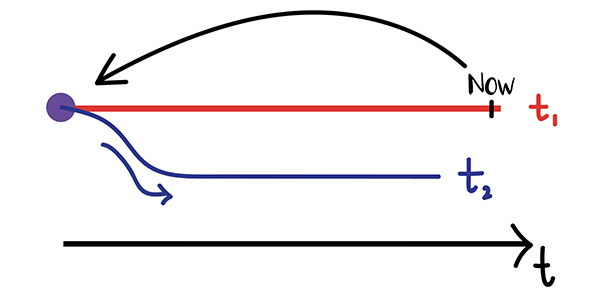
Consider time moving in a forward direction, as depicted by the black axis ‘t’. You are part of the red t1 timeline, at the ‘Now’ position. Suppose you travel back in time to kill your grandfather, a time depicted by the purple dot.
You succeed in killing your grandfather, and immediately an altered future timeline branches out: the blue t2, in which you are not born. In essence, that one alteration sprouted a new universe, with a timeline parallel to the original universe’s timeline.
This isn’t a paradox, because what people who are moving along timeline red t1 will see is you disappearing at the ‘Now’ position, never to return. That’s because in timeline t1 you are born. You would still exist, but in the blue universe. The older, vengeful, you who succeeds in killing your grandfather, would be moving along time t2.
At the purple point, your grandfather is both dead (along timeline t2), and alive (along timeline t1).
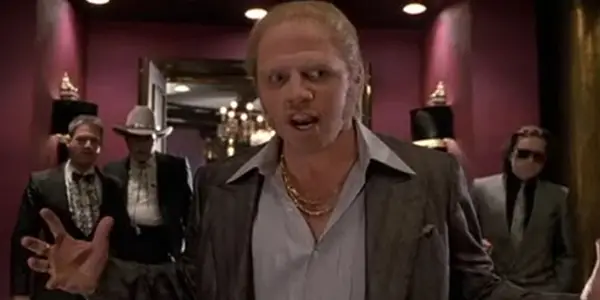
The most classic example of this shifting of timelines is when BTTF bully Biff Tannen becomes President of the United States in a different timeline from the original. In Back to the Future II, the 1955 version of Biff is given a sports almanac by the time-traveling 2015 Biff of the original timeline. At that moment, the universe branches off into a new timeline — one in which Biff uses the statistics of the almanac to get rich and eventually become President.
Pointedly ignoring the parallels to our current timeline, I’d like to say that I believe this solution gives a lot more creative freedom to writers, without the risk of a paradox.
Are there any other solutions to the Grandfather Paradox you can think of? I’d like to hear your thoughts!
More to Explore
Videos
Minute Physics: Solution to the Grandfather Paradox (2016)
Resources
Articles
Gizmodo: Yes, Time Travel Is Possible; Here’s How (time traveling to the future) (2014)
io9 Ask a Physicist: What’s Standing Between Us and Time Travel? (2010)
Books
Travels in Four Dimensions: The Enigmas of Space and Time by Robin Le Poidevin (Note: I haven’t read this yet, but it comes highly recommended)
Does content like this matter to you?
Become a Member and support film journalism. Unlock access to all of Film Inquiry`s great articles. Join a community of like-minded readers who are passionate about cinema - get access to our private members Network, give back to independent filmmakers, and more.
Radha has a PhD in theoretical quantum physics. Apart from research, she consults on sci-fi screenplays/books. In her free time, she cosplays and irritates her three cats. Bug her on Twitter: @RadhaPyari













